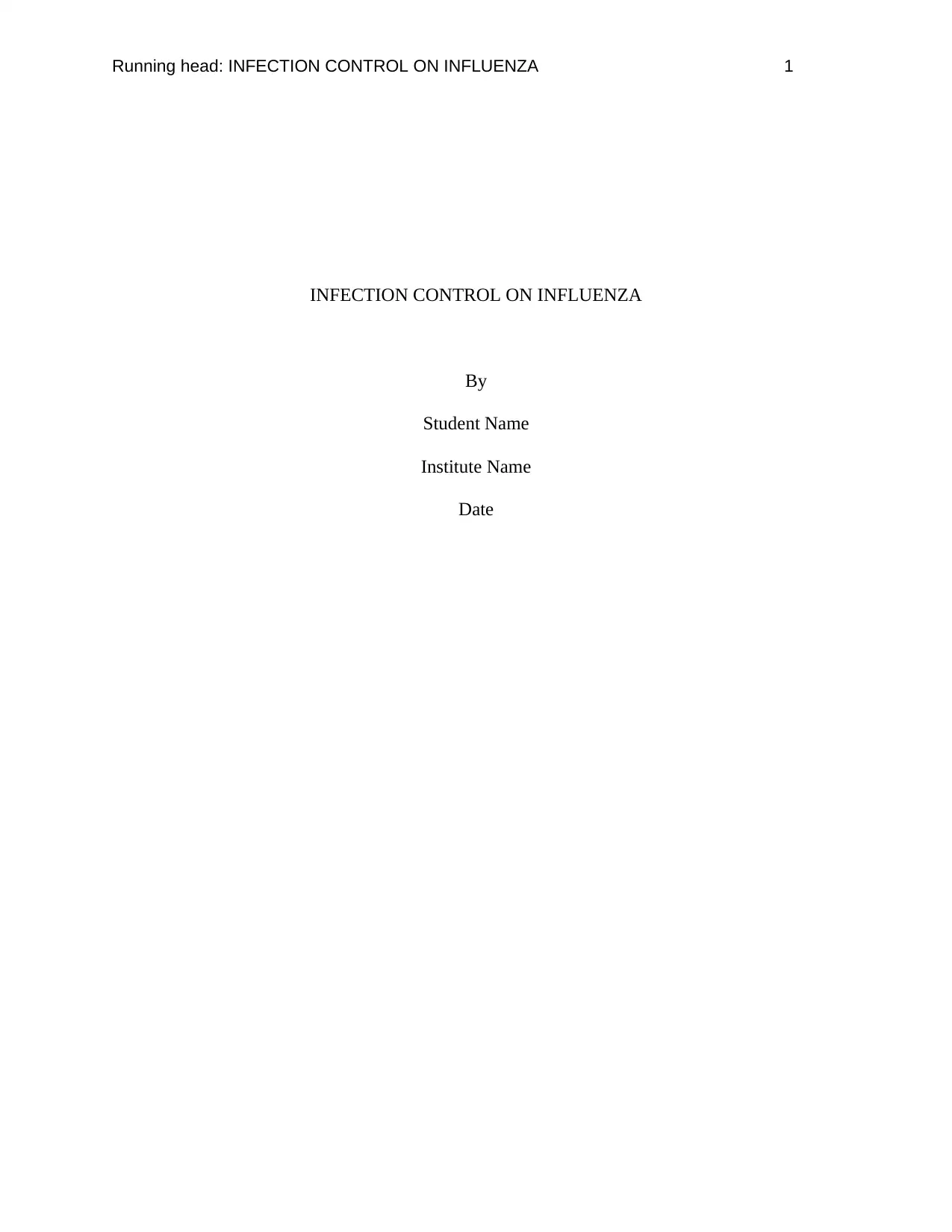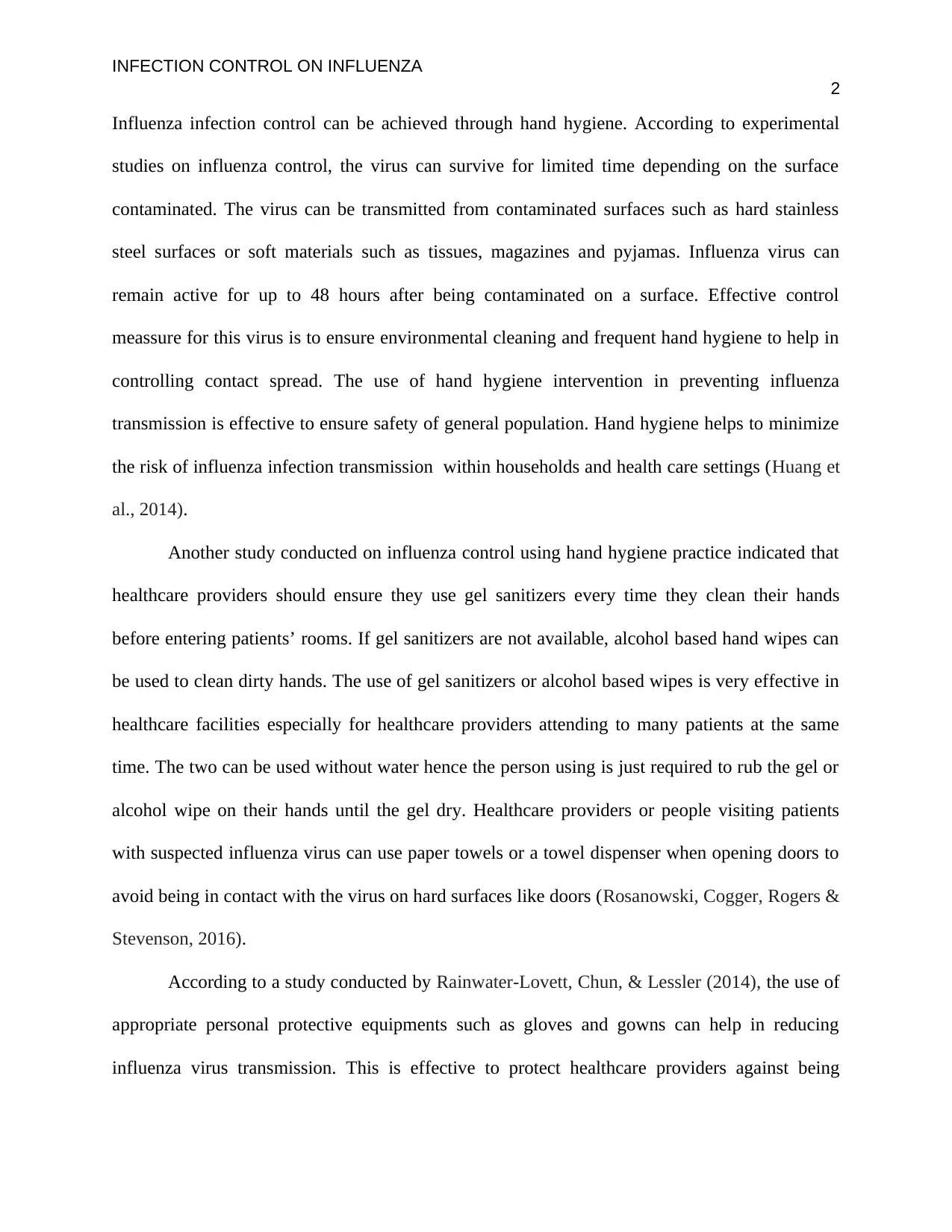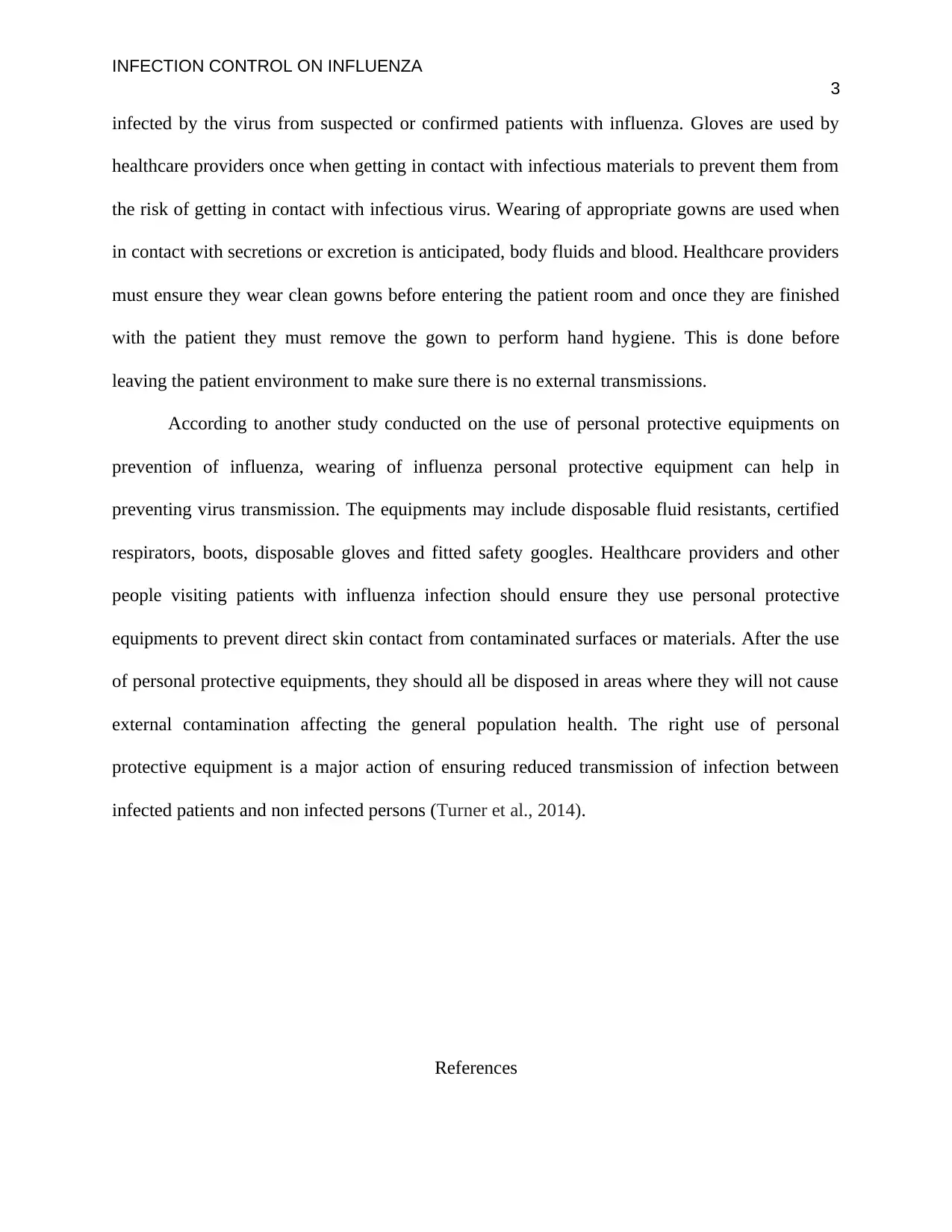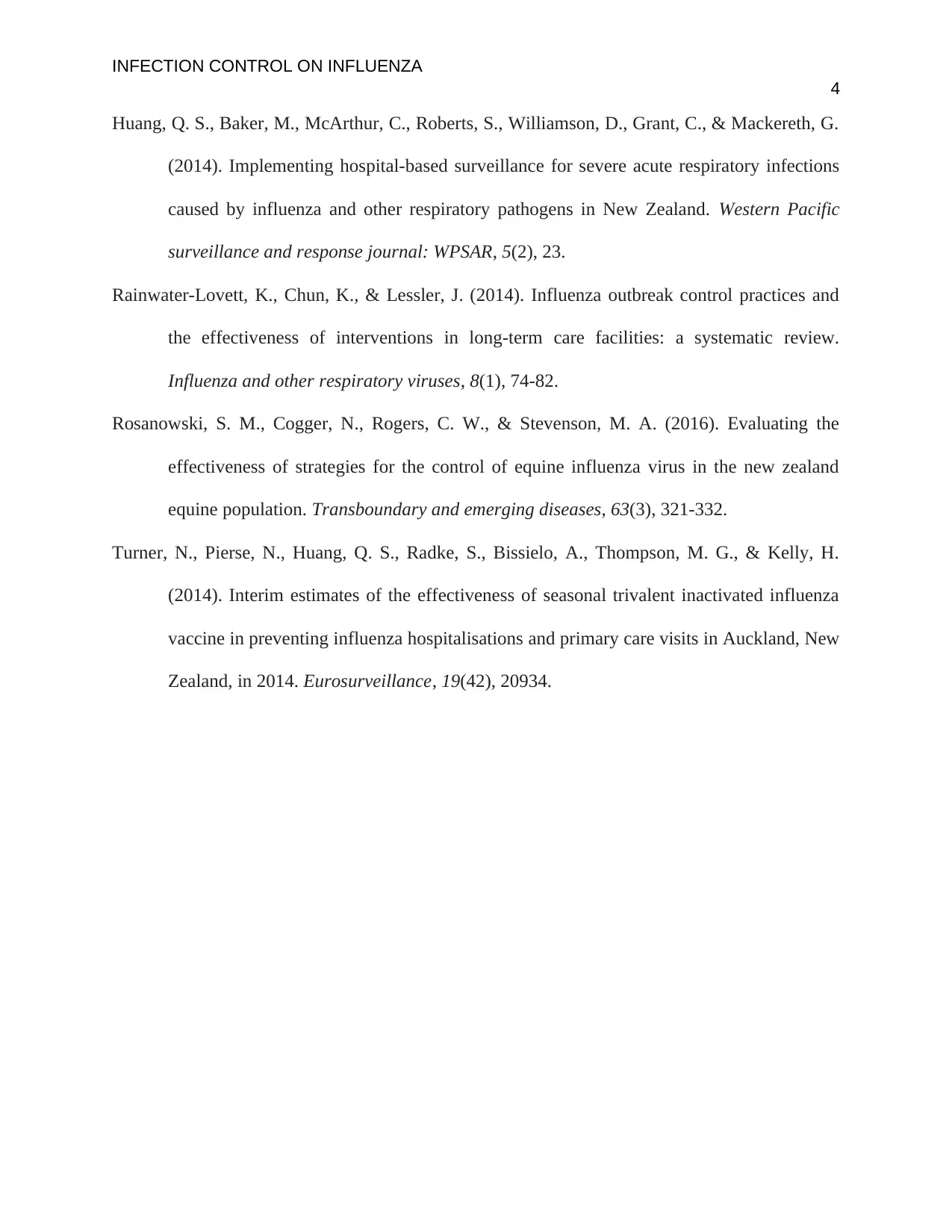Infection Control on Influenza: Hand Hygiene and PPE
VerifiedAdded on 2023/04/21
|4
|861
|186
Report
AI Summary
This report focuses on influenza infection control, emphasizing the importance of hand hygiene and personal protective equipment (PPE) in preventing virus transmission. It discusses how the influenza virus can survive on various surfaces and highlights the effectiveness of hand hygiene interventions in healthcare settings and households. The report also explores the use of gel sanitizers, alcohol-based hand wipes, and appropriate personal protective equipment like gloves, gowns, respirators, and safety goggles. Additionally, it emphasizes the significance of environmental cleaning and proper disposal of contaminated materials to reduce the risk of infection spread. The report references several studies to support the effectiveness of these control measures, aiming to enhance patient safety and public health.

Running head: INFECTION CONTROL ON INFLUENZA 1
INFECTION CONTROL ON INFLUENZA
By
Student Name
Institute Name
Date
INFECTION CONTROL ON INFLUENZA
By
Student Name
Institute Name
Date
Paraphrase This Document
Need a fresh take? Get an instant paraphrase of this document with our AI Paraphraser

INFECTION CONTROL ON INFLUENZA
2
Influenza infection control can be achieved through hand hygiene. According to experimental
studies on influenza control, the virus can survive for limited time depending on the surface
contaminated. The virus can be transmitted from contaminated surfaces such as hard stainless
steel surfaces or soft materials such as tissues, magazines and pyjamas. Influenza virus can
remain active for up to 48 hours after being contaminated on a surface. Effective control
meassure for this virus is to ensure environmental cleaning and frequent hand hygiene to help in
controlling contact spread. The use of hand hygiene intervention in preventing influenza
transmission is effective to ensure safety of general population. Hand hygiene helps to minimize
the risk of influenza infection transmission within households and health care settings (Huang et
al., 2014).
Another study conducted on influenza control using hand hygiene practice indicated that
healthcare providers should ensure they use gel sanitizers every time they clean their hands
before entering patients’ rooms. If gel sanitizers are not available, alcohol based hand wipes can
be used to clean dirty hands. The use of gel sanitizers or alcohol based wipes is very effective in
healthcare facilities especially for healthcare providers attending to many patients at the same
time. The two can be used without water hence the person using is just required to rub the gel or
alcohol wipe on their hands until the gel dry. Healthcare providers or people visiting patients
with suspected influenza virus can use paper towels or a towel dispenser when opening doors to
avoid being in contact with the virus on hard surfaces like doors (Rosanowski, Cogger, Rogers &
Stevenson, 2016).
According to a study conducted by Rainwater‐Lovett, Chun, & Lessler (2014), the use of
appropriate personal protective equipments such as gloves and gowns can help in reducing
influenza virus transmission. This is effective to protect healthcare providers against being
2
Influenza infection control can be achieved through hand hygiene. According to experimental
studies on influenza control, the virus can survive for limited time depending on the surface
contaminated. The virus can be transmitted from contaminated surfaces such as hard stainless
steel surfaces or soft materials such as tissues, magazines and pyjamas. Influenza virus can
remain active for up to 48 hours after being contaminated on a surface. Effective control
meassure for this virus is to ensure environmental cleaning and frequent hand hygiene to help in
controlling contact spread. The use of hand hygiene intervention in preventing influenza
transmission is effective to ensure safety of general population. Hand hygiene helps to minimize
the risk of influenza infection transmission within households and health care settings (Huang et
al., 2014).
Another study conducted on influenza control using hand hygiene practice indicated that
healthcare providers should ensure they use gel sanitizers every time they clean their hands
before entering patients’ rooms. If gel sanitizers are not available, alcohol based hand wipes can
be used to clean dirty hands. The use of gel sanitizers or alcohol based wipes is very effective in
healthcare facilities especially for healthcare providers attending to many patients at the same
time. The two can be used without water hence the person using is just required to rub the gel or
alcohol wipe on their hands until the gel dry. Healthcare providers or people visiting patients
with suspected influenza virus can use paper towels or a towel dispenser when opening doors to
avoid being in contact with the virus on hard surfaces like doors (Rosanowski, Cogger, Rogers &
Stevenson, 2016).
According to a study conducted by Rainwater‐Lovett, Chun, & Lessler (2014), the use of
appropriate personal protective equipments such as gloves and gowns can help in reducing
influenza virus transmission. This is effective to protect healthcare providers against being

INFECTION CONTROL ON INFLUENZA
3
infected by the virus from suspected or confirmed patients with influenza. Gloves are used by
healthcare providers once when getting in contact with infectious materials to prevent them from
the risk of getting in contact with infectious virus. Wearing of appropriate gowns are used when
in contact with secretions or excretion is anticipated, body fluids and blood. Healthcare providers
must ensure they wear clean gowns before entering the patient room and once they are finished
with the patient they must remove the gown to perform hand hygiene. This is done before
leaving the patient environment to make sure there is no external transmissions.
According to another study conducted on the use of personal protective equipments on
prevention of influenza, wearing of influenza personal protective equipment can help in
preventing virus transmission. The equipments may include disposable fluid resistants, certified
respirators, boots, disposable gloves and fitted safety googles. Healthcare providers and other
people visiting patients with influenza infection should ensure they use personal protective
equipments to prevent direct skin contact from contaminated surfaces or materials. After the use
of personal protective equipments, they should all be disposed in areas where they will not cause
external contamination affecting the general population health. The right use of personal
protective equipment is a major action of ensuring reduced transmission of infection between
infected patients and non infected persons (Turner et al., 2014).
References
3
infected by the virus from suspected or confirmed patients with influenza. Gloves are used by
healthcare providers once when getting in contact with infectious materials to prevent them from
the risk of getting in contact with infectious virus. Wearing of appropriate gowns are used when
in contact with secretions or excretion is anticipated, body fluids and blood. Healthcare providers
must ensure they wear clean gowns before entering the patient room and once they are finished
with the patient they must remove the gown to perform hand hygiene. This is done before
leaving the patient environment to make sure there is no external transmissions.
According to another study conducted on the use of personal protective equipments on
prevention of influenza, wearing of influenza personal protective equipment can help in
preventing virus transmission. The equipments may include disposable fluid resistants, certified
respirators, boots, disposable gloves and fitted safety googles. Healthcare providers and other
people visiting patients with influenza infection should ensure they use personal protective
equipments to prevent direct skin contact from contaminated surfaces or materials. After the use
of personal protective equipments, they should all be disposed in areas where they will not cause
external contamination affecting the general population health. The right use of personal
protective equipment is a major action of ensuring reduced transmission of infection between
infected patients and non infected persons (Turner et al., 2014).
References
⊘ This is a preview!⊘
Do you want full access?
Subscribe today to unlock all pages.

Trusted by 1+ million students worldwide

INFECTION CONTROL ON INFLUENZA
4
Huang, Q. S., Baker, M., McArthur, C., Roberts, S., Williamson, D., Grant, C., & Mackereth, G.
(2014). Implementing hospital-based surveillance for severe acute respiratory infections
caused by influenza and other respiratory pathogens in New Zealand. Western Pacific
surveillance and response journal: WPSAR, 5(2), 23.
Rainwater‐Lovett, K., Chun, K., & Lessler, J. (2014). Influenza outbreak control practices and
the effectiveness of interventions in long‐term care facilities: a systematic review.
Influenza and other respiratory viruses, 8(1), 74-82.
Rosanowski, S. M., Cogger, N., Rogers, C. W., & Stevenson, M. A. (2016). Evaluating the
effectiveness of strategies for the control of equine influenza virus in the new zealand
equine population. Transboundary and emerging diseases, 63(3), 321-332.
Turner, N., Pierse, N., Huang, Q. S., Radke, S., Bissielo, A., Thompson, M. G., & Kelly, H.
(2014). Interim estimates of the effectiveness of seasonal trivalent inactivated influenza
vaccine in preventing influenza hospitalisations and primary care visits in Auckland, New
Zealand, in 2014. Eurosurveillance, 19(42), 20934.
4
Huang, Q. S., Baker, M., McArthur, C., Roberts, S., Williamson, D., Grant, C., & Mackereth, G.
(2014). Implementing hospital-based surveillance for severe acute respiratory infections
caused by influenza and other respiratory pathogens in New Zealand. Western Pacific
surveillance and response journal: WPSAR, 5(2), 23.
Rainwater‐Lovett, K., Chun, K., & Lessler, J. (2014). Influenza outbreak control practices and
the effectiveness of interventions in long‐term care facilities: a systematic review.
Influenza and other respiratory viruses, 8(1), 74-82.
Rosanowski, S. M., Cogger, N., Rogers, C. W., & Stevenson, M. A. (2016). Evaluating the
effectiveness of strategies for the control of equine influenza virus in the new zealand
equine population. Transboundary and emerging diseases, 63(3), 321-332.
Turner, N., Pierse, N., Huang, Q. S., Radke, S., Bissielo, A., Thompson, M. G., & Kelly, H.
(2014). Interim estimates of the effectiveness of seasonal trivalent inactivated influenza
vaccine in preventing influenza hospitalisations and primary care visits in Auckland, New
Zealand, in 2014. Eurosurveillance, 19(42), 20934.
1 out of 4
Related Documents
Your All-in-One AI-Powered Toolkit for Academic Success.
+13062052269
info@desklib.com
Available 24*7 on WhatsApp / Email
![[object Object]](/_next/static/media/star-bottom.7253800d.svg)
Unlock your academic potential
Copyright © 2020–2025 A2Z Services. All Rights Reserved. Developed and managed by ZUCOL.





